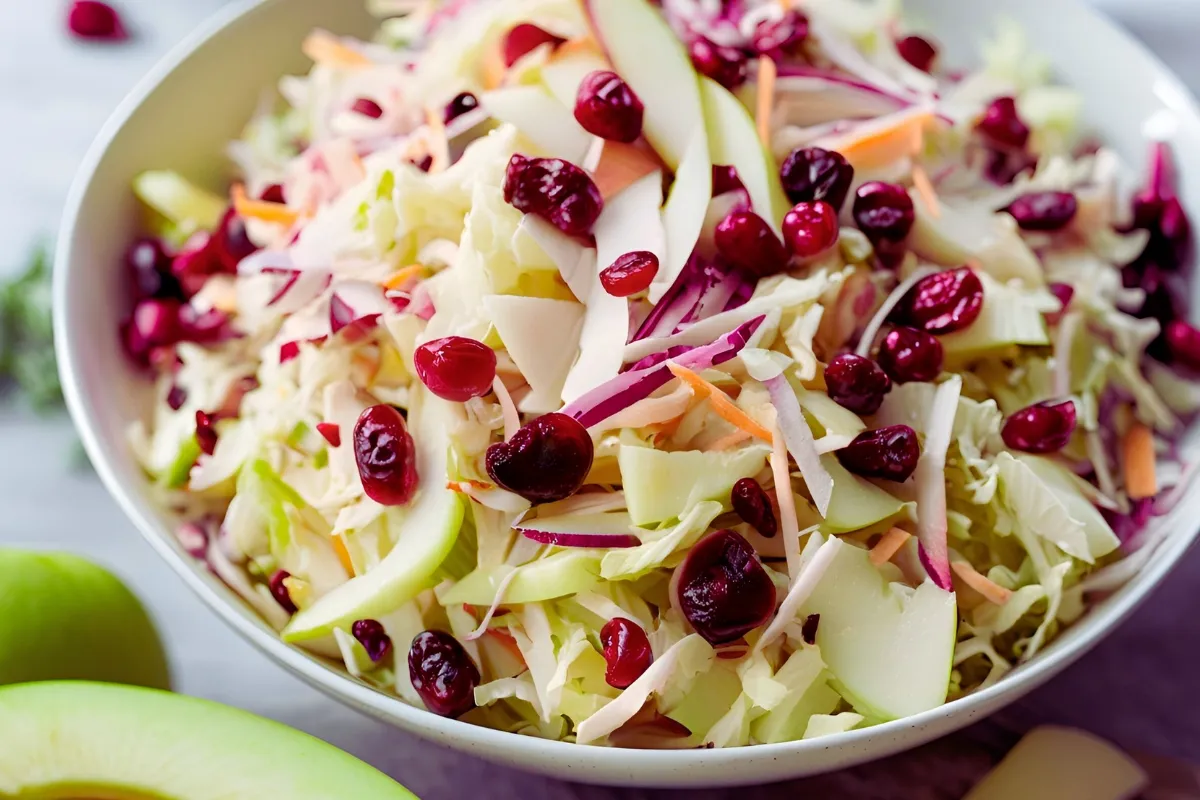Apple Cranberry Coleslaw is a vibrant, refreshing take on the traditional coleslaw. It’s a dish that combines the crunch and texture of classic coleslaw with the sweet and tangy flavors of apples and cranberries. While the classic coleslaw is typically made with shredded cabbage, carrots, and a creamy dressing, adding apples and cranberries brings a delightful fruitiness to the mix, creating a perfect balance between savory, sweet, and tart. It’s a fantastic side dish that’s not only visually appealing but also offers a burst of flavors that can brighten up any meal.
This unique variation is perfect for both casual family dinners and special occasions. Whether you’re looking to add something new to your summer barbecue spread or bring a healthier dish to the holiday table, Apple Cranberry Coleslaw can easily elevate your meal. The best part? It’s easy to prepare and can be customized to suit your taste preferences, making it a crowd-pleaser every time.
What is Apple Cranberry Coleslaw?
Apple Cranberry Coleslaw is a modern take on the classic slaw, swapping out some of the more traditional ingredients for fruits like apples and cranberries. Instead of just cabbage and carrots, this version brings in the sweet-tart crunch of fresh apples and the slightly tart pop of dried or fresh cranberries. The base still typically includes the same classic elements like shredded cabbage and carrots, but the fruit adds a wonderful burst of flavor and texture that is unexpected yet delightful.
The dressing is often a mix of mayonnaise, apple cider vinegar, and a bit of sweetness from honey or maple syrup. This combination gives the slaw a creamy yet tangy flavor that contrasts beautifully with the crunch of the cabbage and the freshness of the apples. In many recipes, the apples are julienned or grated, while cranberries are either fresh or dried, depending on the season and the recipe.
Key Ingredients of Apple Cranberry Coleslaw
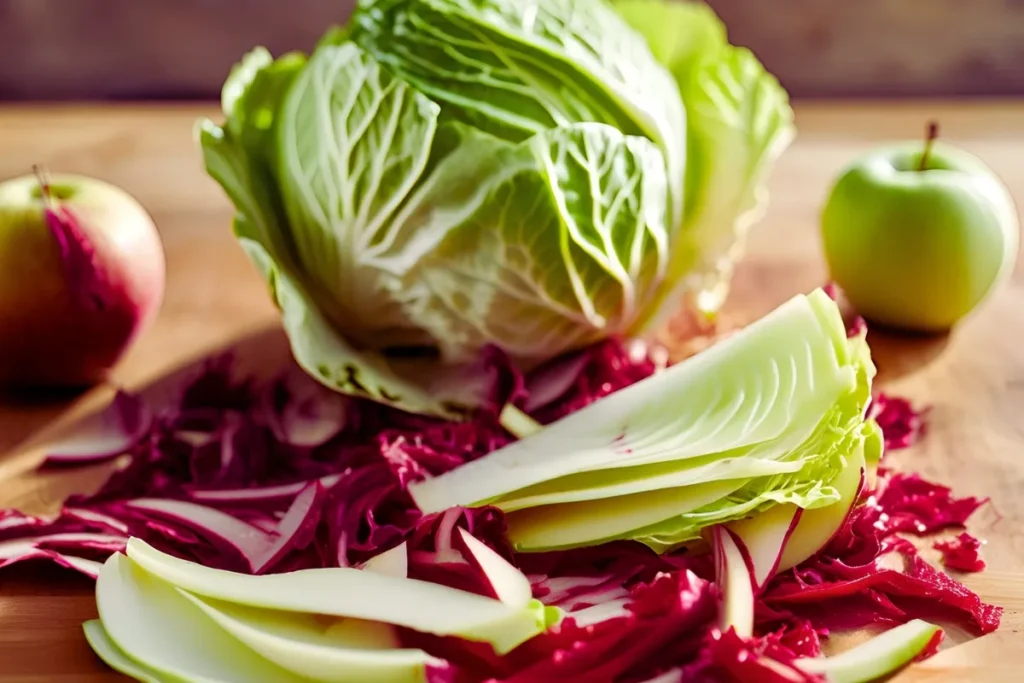
The beauty of Apple Cranberry Coleslaw lies in its simplicity and the balance of its ingredients. Here’s a breakdown of the essential ingredients you’ll need:
- Cabbage: Typically, green cabbage is the base of this slaw, offering that classic crunch we all love. Some recipes might also include red cabbage for an added pop of color.
- Carrots: Thinly shredded carrots add extra color, sweetness, and crunch, making the dish visually appealing and well-rounded.
- Apples: A tart apple variety like Granny Smith is often used to balance the sweetness of the cranberries, but feel free to use whatever apples you like best. Sweet apples like Gala or Fuji work well too!
- Cranberries: Fresh or dried cranberries can be used, with dried cranberries offering a chewy texture and concentrated sweetness.
- Mayonnaise: The classic creamy base for most coleslaws, providing richness and smoothness.
- Apple Cider Vinegar: For that tangy kick, which complements the sweetness of the apples and the slight tartness of the cranberries.
- Honey or Maple Syrup: A touch of sweetness to balance the tangy dressing and the fruit.
- Salt and Pepper: For seasoning and balancing all the flavors.
Apples and Cranberries: Health Benefits and Flavor Combinations
Both apples and cranberries aren’t just flavorful; they also bring health benefits to the dish. Apples, loaded with fiber, help support digestive health, and their antioxidants can contribute to overall wellness. On the other hand, cranberries are known for their immune-boosting properties, particularly in preventing urinary tract infections. Additionally, cranberries are rich in vitamin C and antioxidants, making them a great addition to your diet.
When combined in coleslaw, these two ingredients not only bring flavor but also contribute nutritional value. The sweetness of the apples works wonderfully against the tartness of the cranberries, and both fruits complement the cabbage and carrots without overpowering the dish. This balance of flavors creates a refreshing twist on a classic favorite.
The Appeal of Apple Cranberry in Coleslaw
The combination of apples and cranberries in coleslaw isn’t just about adding color—it’s about enhancing the taste profile of the dish. The crunch of the cabbage pairs beautifully with the juicy sweetness of the apples and the chewy tartness of cranberries. This unexpected fruit twist adds a layer of complexity to the traditional coleslaw that many people find exciting and refreshing.
Incorporating fruit into coleslaw offers an opportunity to experiment with sweet and savory combinations that keep your taste buds on their toes. The crispness of the apples contrasts with the creaminess of the dressing, while the cranberries lend a subtle tanginess that can balance out any richness from the mayo or cream.
Why Choose Apple Cranberry Coleslaw Over Traditional Coleslaw?
Now, you might be wondering why you should consider apple cranberry coleslaw instead of the tried-and-true classic. After all, coleslaw has been a staple at barbecues and family gatherings for years. Well, here’s the thing—apple cranberry coleslaw adds a fresh, fruity twist that can be a real game-changer. The sweetness of the fruit complements the creamy dressing, offering a contrast that traditional coleslaw just can’t match. Plus, it’s a great way to introduce some seasonal ingredients into your meal, especially if you’re serving it in the fall or winter when apples and cranberries are in peak season.
Adding Fruit to Coleslaw for a Sweet and Savory Experience
Fruit adds a natural sweetness to coleslaw, which pairs wonderfully with the savory flavors of cabbage, carrots, and the creamy dressing. Unlike traditional coleslaw, which can sometimes feel a little heavy or one-dimensional, apple cranberry coleslaw brings a refreshing, lighter taste. The fruit doesn’t overpower the other ingredients; instead, it creates a harmonious balance that makes each bite exciting.
Fruit in coleslaw also offers an added layer of versatility. For example, if you want to bring in other fruits—such as pears, raisins, or even citrus—apple cranberry coleslaw is the perfect base for experimentation. It’s a dish that can evolve with the seasons, incorporating fresh fruits when they’re available and switching up the dressing to suit your tastes.
Nutritional Benefits of Apples and Cranberries
Beyond their delightful flavor, apples and cranberries are packed with health benefits. Apples are known for being rich in fiber, especially in their skins, and they’re a great source of vitamins, including vitamin C. Cranberries, while not as commonly eaten on their own, are rich in antioxidants, particularly flavonoids, which can help fight inflammation and promote heart health. Additionally, cranberries are well-known for their ability to help prevent urinary tract infections (UTIs) due to their high levels of proanthocyanidins.
When added to your coleslaw, these fruits not only contribute their health benefits but also provide a natural sweetness that reduces the need for added sugar. This makes Apple Cranberry Coleslaw a healthier option compared to traditional recipes, which can sometimes be overloaded with sugary or overly fatty dressings.
Apples are known for being rich in fiber and vitamins. For more details on the health benefits of apples, check out this article from WebMD.
A Healthier Alternative to Classic Coleslaw Recipes
Apple Cranberry Coleslaw provides a much lighter, fresher alternative to classic coleslaw recipes. Many traditional coleslaw recipes rely heavily on mayo or creamy dressings, which can be high in calories and fat. By incorporating fruit, you’re naturally lowering the calorie count while adding a burst of flavor. Plus, the addition of fresh fruits helps you sneak in more nutrients into your meal, making it a great option for those looking to eat healthier without sacrificing taste.
This modern slaw also opens the door to making it your own. Whether you want to make it vegan, swap out the mayo for a dairy-free alternative, or even experiment with a tangier vinaigrette dressing, Apple Cranberry Coleslaw offers flexibility that traditional coleslaw just can’t provide.
Understanding the Basics of Coleslaw
Before diving deeper into the apple cranberry variation, it’s essential to understand what makes coleslaw a timeless dish in the first place. At its core, coleslaw is a salad made primarily from finely-shredded raw cabbage and dressed most commonly with a vinaigrette or creamy dressing. The dish is extremely versatile and can vary widely depending on the type of dressing used and the addition of other ingredients like carrots, onions, or even fruit.
The simplicity of coleslaw is one of the reasons it has remained a favorite for so many years. It’s not only easy to prepare, but it also pairs well with a variety of dishes, from fried chicken to grilled meats and even alongside sandwiches. Classic coleslaw can be tangy, creamy, or even a little sweet, depending on your preference and the seasonings used.
What Makes a Coleslaw?
A true coleslaw recipe usually consists of three essential elements:
- Cabbage: Cabbage is the main ingredient and forms the base of the slaw. Green cabbage is typically used, although red cabbage can also be included for added color and flavor. It’s usually shredded or finely chopped, ensuring a tender yet crunchy texture.
- Carrots: Shredded carrots add color and sweetness, balancing out the earthiness of the cabbage. These are a common addition in most coleslaw recipes, and they contribute a pop of color that makes the dish more appealing.
- Dressing: This is where the magic happens. Coleslaw dressings can vary significantly, with some using a tangy vinegar-based dressing, while others go for a creamier mayonnaise-based version. Dressings usually include ingredients like vinegar, mayonnaise, sugar, mustard, and various seasonings.
The beauty of coleslaw is in its adaptability. You can adjust the flavors to suit your taste, from tangy and spicy to sweet and creamy. Moreover, you can add additional ingredients like apples, raisins, or even cheese to bring a new twist to the dish, which is precisely where the Apple Cranberry Coleslaw shines.
What is the Difference Between Coleslaw and Slaw?
While coleslaw is widely recognized, you might have heard the term “slaw” thrown around as well. So, what exactly is the difference between the two?
The short answer is that slaw is simply a shortened term for coleslaw. However, in modern culinary terms, the distinction often comes down to the ingredients and the type of dressing used. The word “slaw” can sometimes refer to any type of shredded vegetable salad, not just one made with cabbage. For example, you might see “broccoli slaw” or “carrot slaw,” where the cabbage is replaced with other vegetables.
Though the ingredients may vary, the core concept remains the same: shredded vegetables dressed with a flavorful dressing. So, when you make Apple Cranberry Coleslaw, it can technically be referred to as “slaw,” but we still call it “coleslaw” because cabbage remains the base.
Coleslaw vs Slaw: Key Ingredients and Variations
Here’s a breakdown of the key differences between coleslaw and slaw:
| Coleslaw | Slaw |
|---|---|
| Base: Cabbage and often carrots | Base: Any shredded vegetable (cabbage, broccoli, carrots, etc.) |
| Dressing: Typically creamy or tangy vinaigrette | Dressing: Can vary widely, from creamy to vinegar-based |
| Flavor Profile: Classic coleslaw leans toward creamy, tangy, or sweet | Flavor Profile: Depends on the vegetables used and the dressing |
Slaw gives you room to get creative, using a variety of vegetables or fruits, and switching up the dressings to make it a bit different each time. This flexibility is why Apple Cranberry Coleslaw is so exciting!
How to Make Jamie Oliver’s Coleslaw
If you’re looking to make a truly standout coleslaw, you can always follow the tried-and-true methods of famous chefs like Jamie Oliver. Jamie’s take on coleslaw is fresh, full of flavor, and keeps things simple. He’s known for using high-quality, fresh ingredients and a bright, zesty dressing that really highlights the vegetables’ natural flavors.
Oliver’s approach to coleslaw often includes using fresh herbs like parsley or dill for a burst of freshness and flavor. His recipe is typically light and balanced, allowing the natural flavors of the cabbage and carrots to shine through while keeping the dressing light and tangy.
Jamie Oliver’s Approach to Coleslaw: Fresh Ingredients and a Unique Twist
Oliver’s method of coleslaw preparation emphasizes quality ingredients and simplicity. He focuses on using crisp, fresh cabbage and carrots, ensuring that the vegetables remain crunchy and vibrant. In some of his variations, he adds fresh citrus juice or even a dash of apple cider vinegar to give the slaw an extra zing.
A key element of Jamie Oliver’s style is using less mayo and more natural ingredients like yogurt or sour cream to create a creamy, lighter dressing. He might also incorporate some Dijon mustard for a tangy kick, giving the coleslaw a depth of flavor that’s not too heavy or greasy.
Mary Berry’s Coleslaw Recipe
Mary Berry, a British culinary icon, has her own version of coleslaw, and it’s just as delightful. Her approach typically uses a more traditional take on coleslaw but incorporates simple, fresh ingredients for maximum flavor. The key to Mary Berry’s coleslaw is her focus on balance. She aims for a dressing that’s creamy but not overpowering, with the perfect amount of sweetness and tang.
Berry’s recipes often include a small amount of lemon juice or vinegar to cut through the richness of the mayo and make the dish feel light. She might also include finely diced onions or a sprinkle of herbs to elevate the flavor.
How Mary Berry’s Coleslaw Differs from Traditional Versions
While Mary Berry’s coleslaw stays true to the classic version, she sometimes opts for a little twist—like adding a small amount of mustard or a touch of horseradish to spice things up. These elements make her version stand out by offering a mild, tangy flavor without being overpowering. Her balance of sweetness, acidity, and creaminess is key, and it’s this skill that elevates her coleslaw from good to great.
Practical Tips for Making Apple Cranberry Coleslaw
Making Apple Cranberry Coleslaw isn’t just about following a recipe—it’s about experimenting with flavors, textures, and even seasonal variations to craft a dish that fits your style. Whether you’re making it for a family dinner, a holiday gathering, or a casual barbecue, there are some tried-and-true tips that can help make your coleslaw stand out.
The beauty of Apple Cranberry Coleslaw is its flexibility. You can make it as simple or as complex as you like, depending on what ingredients you have on hand and your personal preferences. To get it just right, here are some practical tips to keep in mind:
- Use a Sharp Knife or Shredder: For the best texture, it’s essential to slice or shred the cabbage and carrots finely. This ensures each bite has the perfect balance of crunch and flavor.
- Let the Slaw Sit Before Serving: While it’s tempting to dive right in, letting the slaw sit for about 30 minutes to an hour allows the flavors to meld together. It also gives the dressing time to soften the cabbage and carrots, making the slaw more flavorful and tender.
- Adjust the Dressing: Depending on how creamy or tangy you like your slaw, feel free to adjust the dressing. If you prefer it lighter, reduce the amount of mayo and use more apple cider vinegar or a touch of Greek yogurt to balance it out.
Step-by-Step Guide to Making Apple Cranberry Coleslaw
Now that we’ve covered some practical tips, let’s dive into a simple yet flavorful recipe for Apple Cranberry Coleslaw. This step-by-step guide will help you create a delicious dish that can be served at any occasion!
Essential Ingredients for Apple Cranberry Coleslaw
For this recipe, you’ll need the following ingredients:
- 1 small head of green cabbage, shredded
- 2 medium carrots, peeled and grated
- 2 apples, julienned (Granny Smith or Honeycrisp work best)
- 1 cup dried cranberries (you can also use fresh cranberries if you prefer)
- 1/2 cup mayonnaise
- 2 tablespoons apple cider vinegar
- 1 tablespoon honey or maple syrup
- Salt and pepper, to taste
Preparing the Vegetables and Fruits
- Shred the cabbage: Start by shredding the cabbage as finely as possible. You can use a sharp knife or a mandolin slicer to ensure the pieces are uniform. The smaller and finer the cabbage, the more flavorful each bite will be.
- Grate the carrots: After peeling the carrots, use a grater or food processor to grate them into thin strips. This adds color and sweetness to the slaw.
- Prepare the apples: Julienne the apples to create thin, matchstick-like pieces that will add a crisp and slightly sweet crunch. If you prefer a more subtle apple flavor, you can also grate them instead.
Mixing the Perfect Dressing for Apple Cranberry Coleslaw
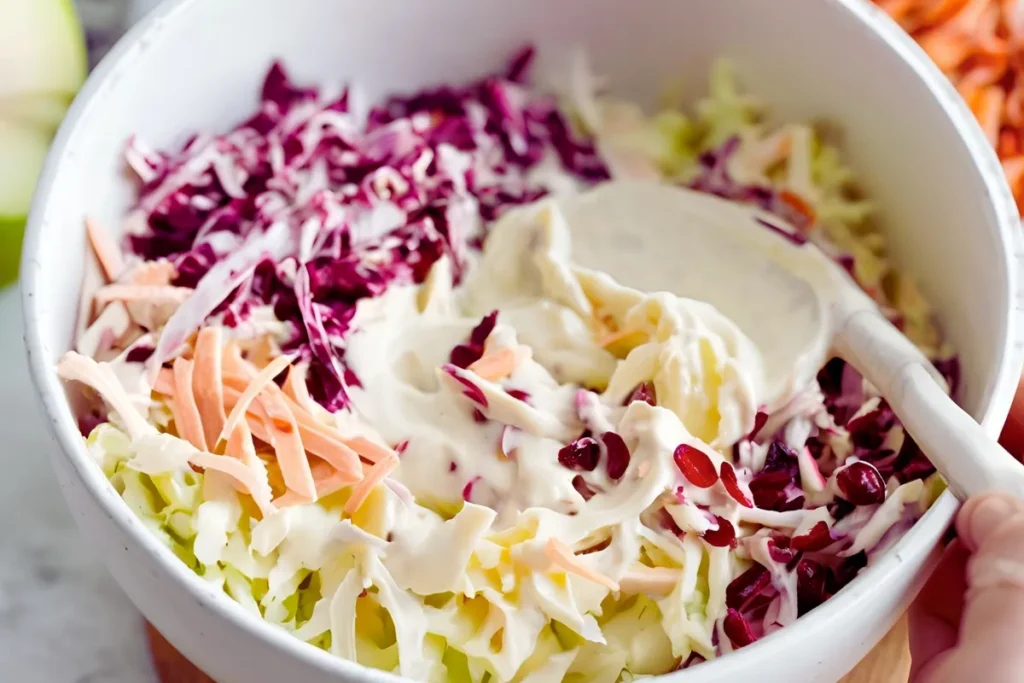
The dressing is what brings all the flavors together. The creamy mayonnaise combined with the tangy apple cider vinegar and the sweetness from honey or maple syrup creates the perfect balance of flavors.
- Combine the mayonnaise and vinegar: In a small bowl, whisk together the mayonnaise and apple cider vinegar. This will form the base of your dressing, which will be creamy with just the right amount of acidity.
- Add the sweetener: Stir in the honey or maple syrup. You can adjust the amount depending on how sweet you want the dressing to be.
- Season: Add salt and pepper to taste. The seasoning helps balance out the sweetness and tanginess, so don’t skip this step!
Tossing Everything Together
Once all the ingredients are prepared, toss the cabbage, carrots, apples, and cranberries together in a large mixing bowl. Then, pour the dressing over the mixture and toss again until everything is evenly coated.
Allow the coleslaw to sit for about 30 minutes in the fridge to let the flavors develop. This resting time will also allow the cabbage to soften a bit, making it even more tender and flavorful.
Variations and Customizations for Apple Cranberry Coleslaw
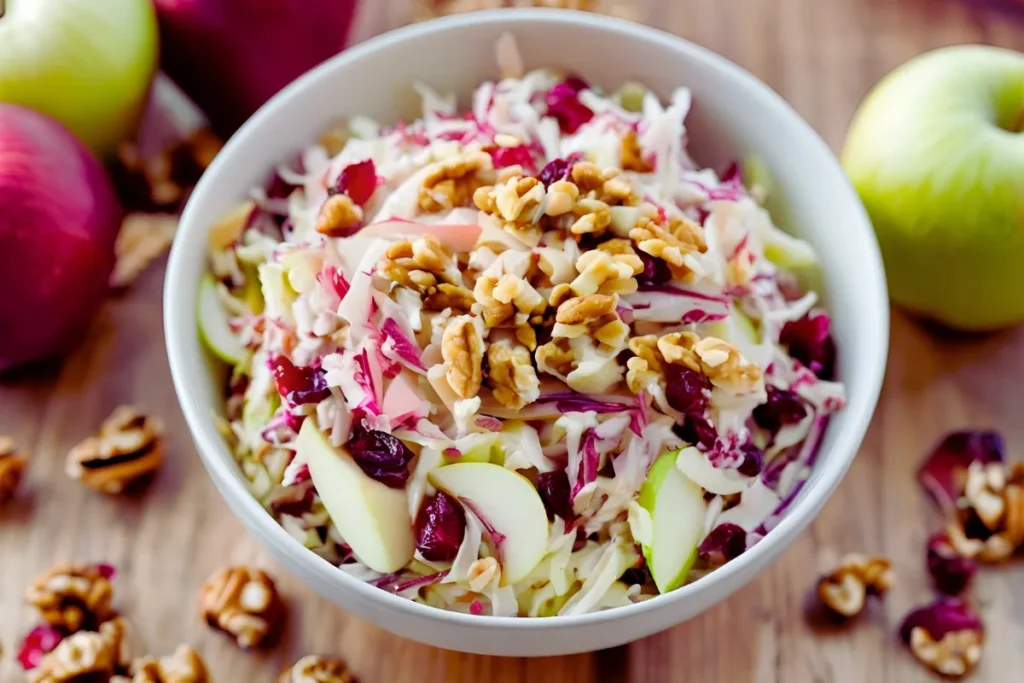
One of the best things about Apple Cranberry Coleslaw is how adaptable it is. You can play around with the ingredients to make it uniquely yours. Here are a few variations to consider:
Incorporating Different Fruits and Vegetables
While apples and cranberries are the stars of this recipe, you can add a variety of other fruits and vegetables to change things up. For example:
- Pears: Pears can be used instead of apples for a slightly different flavor profile. They bring a more delicate sweetness that pairs well with the tartness of cranberries.
- Citrus: Adding some orange segments or a bit of lime zest can introduce a fresh, zesty element that brightens up the coleslaw even more.
- Red Cabbage: For a pop of color and a slightly more peppery flavor, try incorporating some red cabbage into the mix alongside the green cabbage.
Adding Nuts, Seeds, or Cheese for Extra Texture
For added crunch and texture, consider adding nuts, seeds, or even a bit of cheese:
- Pecans or walnuts: Chopped nuts can add a rich, crunchy element that contrasts nicely with the crisp vegetables and fruits.
- Sunflower seeds: A great option for adding a subtle crunch without overpowering the other flavors.
- Cheese: A sprinkle of crumbled feta or sharp cheddar can add a salty bite that pairs perfectly with the sweet and tangy dressing.
If you’re looking to balance your Apple Cranberry Coleslaw with a savory, fruity dish, consider adding an Asian Chicken Cranberry Salad to your menu. The tartness of cranberries in both dishes creates a delightful harmony, making them a perfect pairing for any meal.
Conclusion: Why Apple Cranberry Coleslaw is a Must-Try Dish
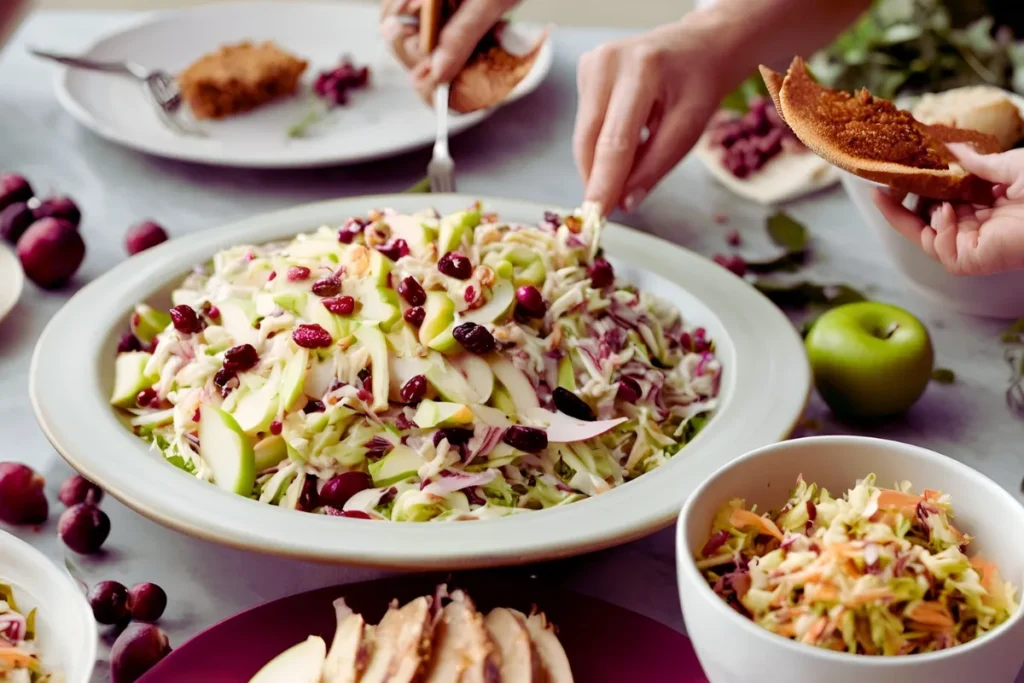
Apple Cranberry Coleslaw is a refreshing and vibrant alternative to the traditional slaw. It’s perfect for any occasion, from casual weeknight dinners to more festive gatherings. The combination of crisp cabbage, sweet apples, and tart cranberries creates a unique balance of flavors that will make your taste buds dance. Add in the creamy dressing, and you have a dish that’s both satisfying and exciting.
What makes Apple Cranberry Coleslaw stand out is how easily you can customize it. Whether you prefer a lighter dressing, want to swap out fruits, or are looking for extra texture with nuts and cheese, this dish is endlessly adaptable. Plus, with the added health benefits of apples and cranberries, you’re not only treating your taste buds but also nourishing your body.
Next time you’re planning a meal or looking for a standout side dish, don’t hesitate to try Apple Cranberry Coleslaw—it’s a surefire hit that everyone will love!
How Do You Make Jamie Oliver Coleslaw?
What Ingredients are Needed for Jamie Oliver’s Coleslaw Recipe?
Jamie Oliver’s coleslaw recipe calls for simple yet fresh ingredients. You’ll need cabbage, carrots, fresh herbs like parsley, and a few pantry staples such as vinegar, mayonnaise, mustard, and a bit of honey. Jamie’s version is often lighter, with less mayo than traditional coleslaw, and he emphasizes using high-quality, fresh produce. This helps the flavors shine without being weighed down by heavy dressings.
What Makes Jamie Oliver’s Coleslaw Unique?
Jamie Oliver’s coleslaw stands out due to its use of fresh ingredients and the balance of tangy and creamy flavors. His dressing typically features a mix of mayonnaise and yogurt, giving it a creamy yet light texture. Additionally, Jamie often adds fresh herbs like parsley or mint to elevate the flavor profile, making his coleslaw vibrant and refreshing, perfect for any occasion.
What is Apple Cranberry Good For?
Health Benefits of Apples and Cranberries in Your Diet
Apples and cranberries are not only delicious but also incredibly healthy. Apples are rich in dietary fiber, which supports digestion and helps maintain a healthy heart. Cranberries are packed with antioxidants, particularly vitamin C, which helps boost the immune system and protect cells from damage. Additionally, cranberries are known for their role in preventing urinary tract infections (UTIs). Together, they make Apple Cranberry Coleslaw a nutrient-dense dish that’s as good for your body as it is for your taste buds.
What’s the Difference Between Coleslaw and Slaw?
Key Variations Between Coleslaw and Slaw
The main difference between coleslaw and slaw lies in the ingredients and sometimes the dressing. Coleslaw typically refers to a dish made with cabbage, carrots, and a creamy dressing, whereas “slaw” can refer to any shredded vegetable salad, not necessarily with cabbage. Additionally, slaw can be dressed with a variety of options, from creamy to vinaigrette, and may include ingredients like broccoli, fennel, or even fruits like apples or raisins.
Is Coleslaw Always Made with Cabbage?
While cabbage is the most common base for coleslaw, it’s not always a requirement. Some variations of slaw might use different vegetables, such as broccoli or kale. However, the classic coleslaw recipe traditionally uses cabbage as the foundation, thanks to its crunchy texture and ability to hold up well against dressings.
How to Make Coleslaw Mary Berry?
Key Steps in Mary Berry’s Coleslaw Recipe
Mary Berry’s coleslaw recipe is straightforward yet delicious. She starts by shredding cabbage and carrots, ensuring they’re finely chopped for the right texture. The dressing is typically a blend of mayonnaise, vinegar, and a bit of sugar to balance the tanginess with sweetness. Mary’s twist often includes adding lemon juice or a touch of mustard to give the coleslaw extra zing. It’s all about achieving that perfect balance of flavors.
Differences Between Mary Berry’s and Traditional Coleslaw Recipes
Mary Berry’s approach to coleslaw is similar to traditional recipes, but she often adds a few extra touches to elevate the dish. For instance, the addition of mustard or lemon juice adds complexity and enhances the overall flavor. Furthermore, her dressing is usually lighter, with a bit of vinegar to cut through the creaminess, creating a fresher, more vibrant coleslaw compared to the heavier versions that rely more heavily on mayo.

